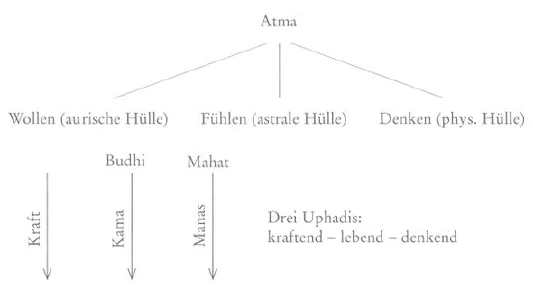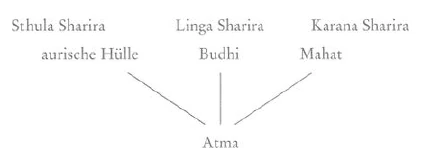Self-Knowledge and God-Knowledge II
Theosophy, Christology and Mythology
GA 90b
18 August 1905(?), Berlin
Translated by Steiner Online Library
XIII. The Seven Principles
Atma consists of seven principles: 1. auric covering, 2. Budhi, 3. Manas, 4. Kama Manas, 5. Kama, 6. Physis.
This seven-principle being has three states of consciousness, also called 'destinies' or 'upadhis'. Atma lives in three upadhis:
1. physical - strength
2. astral - living
3. manasic - thinking.

Sthula Sharira: The entire mineral kingdom has not awakened. It is powerful, that is, it is, but it does not feel and does not think its being.
Linga Sharira: Plants and animals have partially awakened. They live, that is, they feel, but they do not think their being.
Karana Sharira: People have awakened. They think, that is, they think their being.
Let us imagine a personality, it is perceived and it is recognized. We therefore have subject and object. Furthermore, the subject perceives itself, it places itself, as it were, outside of itself and makes itself an object; its I stands above the external expression of its I. It is, perceives itself and thinks.
Let us imagine Atma. In order to perceive itself, Atma must manifest itself, that is, it must make itself known through an act of will; it must be and therefore surrounds itself with a fine shell, which we call the auric shell.
Now Atma perceives itself, it feels, senses itself as a being and thereby forms the astral shell in the auric shell. - Second aspect: the world as feeling/Budhi.
In order to have an idea of itself, Atma must step out of itself, it now makes itself objective and thus creates the physical shell. - Third aspect: the world as thinking / Mahat.
We now have Atma, which permeates everything seven times: three times subjectively and three times objectively in its aspects, and once as itself.
If we consider the objective side in its descent, in the “separation of Atma, we find will without spirit as force, feeling without spirit as Kama, thinking without spirit as concrete Manas. In its ascent, that is, in its return to the welling Atma, Kama becomes Budhi, Manas becomes Mahat, the force becomes the auric covering. Everything is absorbed again into Atma: if a being is to come to itself, it must consist of seven principles. The number seven in the objective world and in man:

A being can awaken in three states of consciousness, that is, in its three shells: as energy, as life – or as feeling – and as thought.
In the mineral kingdom, the being has awakened only as energy; in the plant kingdom, as life; in the animal kingdom, as life and feeling; in the human kingdom – as thought.
XIII. Die Sieben Prinzipien
Berlin, 18. August (1905?)
Atma besteht beim Menschen aus sieben Prinzipien: 1. aurische Hülle, 2. Budhi, 3. Manas, 4. Kama Manas, 5. Kama, 6. Physis.
Dieses aus sieben Prinzipien bestehende Wesen hat drei Bewusstseinszustände, auch ‹Bestimmungen› oder ‹Upadhis› genannt. Atma lebt in drei Upadhis:
1. kraftend - physisch
2. lebend - astralisch
3. denkend - manasisch

Sthula Sharira: Das ganze Mineralreich ist nicht in sich erwacht. Es kraftet, das heißt, es ist, aber es fühlt nicht und denkt nicht sein Sein.
Linga Sharira: Pflanzen und Tiere sind teilweise in sich erwacht. Sie leben, das heißt, sie fühlen, aber denken nicht ihr Sein.
Karana Sharira: Menschen sind erwacht. Sie denken, das heißt, sie denken ihr Sein.
Denken wir uns eine Persönlichkeit, sie ist und sie wird wahrgenommen. Wir haben also Subjekt und Objekt. Außerdem nimmt das Subjekt sich selbst wahr, es stellt sich gleichsam außer sich und macht sich zum Objekt; sein Ich steht über dem äußeren Ausdruck seines Ich. Es ist, nimmt sich wahr und denkt.
Denken wir uns Atma. Um sich selbst wahrzunehmen, muss Atma sich manifestieren, das heißt durch eine Willenshandlung kundgeben; es muss sein und umgibt sich deshalb mit einer feinen Hülle, die wir die aurische Hülle nennen. - Erster Aspekt: die Welt als Wille/Atma.
Nun nimmt Atma sich wahr, er fühlt, empfindet sich als seiendes Wesen und bildet dadurch in der aurischen die astrale Hülle. - Zweiter Aspekt: die Welt als Fühlen/Budhi.
Um von sich eine Vorstellung zu haben, muss Atma aus sich heraustreten, er macht sich nun objektiv und schafft sich so die physische Hülle. - Dritter Aspekt: die Welt als Denken / Mahat.
Wir haben nun hier Atma, das alles durchflutet siebenmal: dreimal subjektiv und dreimal objektiv in seinen Aspekten, und einmal als sich selbst.
Betrachten wir die objektive Seite in ihrem Niederstieg, in der "Trennung von Atma, so finden wir Wille ohne Geist als Kraft, Fühlen ohne Geist als Kama, Denken ohne Geist als konkreten Manas. In ihrem Aufstieg, das heißt in ihrer Rückkehr zum quellenden Atma wird Kama zu Budhi, Manas zu Mahat, die Kraft zur aurischen Hülle. Alles geht wieder ein in Atma: Wenn ein Wesen zu sich kommen soll, muss es aus sieben Prinzipien bestehen. Die Sieben-Zahl in der objektiven Welt und im Menschen:

Ein Wesen kann in drei Bewusstseinszuständen erwachen, das heißt in seinen drei Hüllen: kraftend, lebend - oder fühlend - und denkend.
Im Mineralreich ist das Wesen nur kraftend erwacht; im Pflanzenreich lebend; im Tierreich lebend und fühlend; im Menschen -— denkend.

